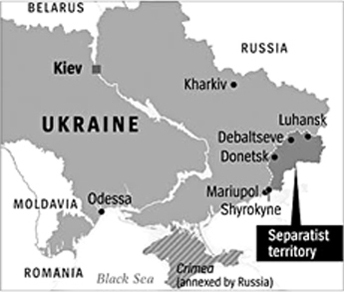

Vol. 79/No. 34 September 28, 2015

|
At the same time the capitalist rulers of Ukraine are seeking to stabilize their crisis-ridden economy and relations with imperialist lenders by deepening attacks on the working class. The government headed by billionaire President Petro Poroshenko is clamping down on political and union rights, trying to roll back the space and self-confidence workers and others won in the popular upsurge that ousted Moscow-backed President Viktor Yanukovych in February 2014.
As part of efforts to reach a more secure set of international alliances in a world of growing crisis, the Barack Obama administration has been seeking a “reset” with the Vladimir Putin regime, signaling its willingness to accept a buffer zone in eastern Ukraine, which Moscow considers its “near abroad.”
Washington needs to accept “Moscow as a great power that possesses real and legitimate interests, especially in its border areas,” wrote former State Department official and long-time leader of the Council on Foreign Relations Leslie Gelb in June. Doing so, he said, will allow the U.S. and Russian governments to “step up joint action based on common interests on other critical fronts such as terrorism, Syria, Iran and nuclear proliferation.”
In the wake of Yanukovych’s ouster, Putin moved to prevent Washington and NATO from exerting influence on Russia’s border, organizing the occupation and annexation of the Crimean Peninsula and launching attacks on the native Tatar people there. Moscow also instigated separatist forces, sending in soldiers, weapons and advisers, to seize areas in Donetsk and Luhansk, fueling a war that has left nearly 8,000 dead in the last year and a half.
In February the German and French governments brokered an agreement in Minsk, Belarus, between Kiev, Moscow and its separatist followers. Under the deal, the Ukrainian government will not regain control over the eastern border with Russia until a political settlement is reached creating a decentralized, special status in the separatist-run areas, ensuring Moscow’s ongoing sway.
As part of implementing the Minsk agreement, the Ukrainian parliament approved a constitutional change Aug. 31 that grants the regions more autonomy. In their sharpest clash with the government to date, members of the rightist Svoboda Party and Right Sector protesting the vote attacked police and national guard forces outside the parliament, detonating an explosive device, killing three and injuring dozens.
Within the so-called People’s Republic of Donetsk, a Sept. 4 shake-up put Denis Pushilin in charge of the separatist parliament, ousting Andrey Purgin, who had opposed the Minsk agreement and called for Moscow to annex eastern Ukraine. Pushilin, whose background includes participation in a massive Ponzi scheme in Russia in the 1990s, is seen as “always ready to precisely follow Kremlin orders,” Volodymyr Fesenko, a Kiev-based political analyst, told the Associated Press.
Gov’t assaults workers’ rights
For working people in Ukraine, the biggest threat comes from the Poroshenko government as it drives to advance the interests of Ukrainian capitalists. Parliament is expected to approve a draft labor law later in September that would give bosses more power to set work rules, impose forced overtime, and expand use of temporary workers.The rulers have given the green light to a wave of physical assaults against the Communist Party of Ukraine. CP offices have been fire-bombed, members beaten and framed up, and the party barred from participating in coming elections in December. This is the leading edge of the use of thuggery as well as legal assaults against trade unionists and others who oppose government policies.
In August the government banned 38 books from being imported from Russia and published a list of artists who “pose a threat to national security.” In June it canceled permission for the Socialist Ukraine party to publish its newspaper. These follow the “decommunization” laws Poroshenko signed in May, which attempt to dictate one “official” version of history and were used to justify banning the Communist Party.
Dozens of masked men who said they were with the Right Sector attacked the office of the Opposition Bloc in Kharkiv Aug. 3, trying to stop the party, which includes members of Yanukovych’s former Party of Regions, from registering candidates in the elections.
Coal miners and other workers have had to strike and protest in ongoing efforts to receive their wages. Starting Aug. 26, miners at the Selidivvugillia mine, backed by the Independent Trade Union of Coal Miners of Ukraine, went on strike and blocked roads, demanding back pay, safer working conditions and improved health care.
Meanwhile, Crimean Tatar leaders forced out of their homeland by the Russian occupation announced plans to launch a protest along the border between Crimea and the rest of Ukraine in late September. They are demanding that Moscow release Ukrainian political prisoners, remove restrictions on Crimean Tatar and Ukrainian media in Crimea, stop persecuting Tatars and other Ukrainian nationals and remove the ban on Refat Chubarov, Mustafa Dzhemilev and other Tatar leaders.
Front page (for this issue) | Home | Text-version home